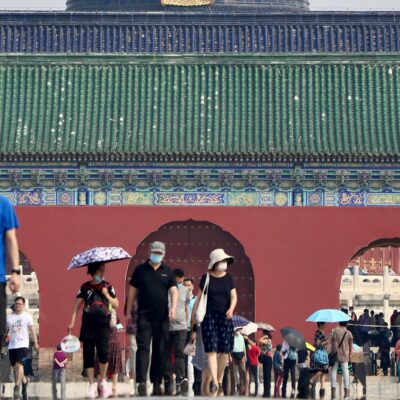In the 1993 movie Jurassic Park, one of the first encounters is with a Triceratops. Outwardly fearsome looking, this herbivorous dinosaur is gravely ill. Its impressive bulk and body armour mask its pusillanimity. The historian John Lewis Gaddis (1997, p. 284) used this metaphor to describe the Soviet Union:
From the outside, as rivals contemplated its sheer size, tough skin, bristling armament, and aggressive posturing, the beast looked sufficiently formidable that none dared tangle with it. Appearances deceived, though, for within its digestive, circulatory, and respiratory systems were slowly clogging up, and then shutting down.
Is the People’s Republic of China (PRC) another triceratops? Have its competitors panicked over its military exoskeleton and forgotten what this might conceal? Does the ubiquity of China economically obscure the many challenges Beijing faces? This article considers four points of potential weakness: geography, ideology, economics, and diplomacy. It asks whether these weaknesses make conflict more or less likely. On balance, I argue that they do and offer some explanations why.
Strengths, of course, are many. The argument is not that the PRC is a dinosaur (a species ultimately destroyed by an asteroid rather than its own internal weaknesses) or that it is a paper tiger or dragon. The demise of the Soviet Union is a tempting though highly problematic model of how we should understand where China is tending. The PRC possesses enormous actual and potential strength—both well documented. The rise and the attendant achievements of the Chinese people since their leaders opened to global trade in the post-Mao era (since 1976) have been remarkable.
From a massive man-made famine state 60 years ago, through the dislocations of the Cultural Revolution (1966-76), and transition from Maoism to state capitalism, China has re-emerged as a decisive power in world affairs. If the answer to every question in international relations for much of the 20th century was ‘American power,’ the ‘rise of China’ has replaced it in the 21st century. Australian wealth would be unimaginable without Chinese customers. Western universities’ business models have been predicated on satisfying an ambitious Chinese middle class. They send their children to Australia (150,000 per year before the pandemic); Australians send 85 percent of their iron ore to China.
China’s military strength has increased in tandem with its economic rise. Impressive figures for defence spending should not conceal the regime’s ability to engage in coercive ‘grey zone’ activities: the destabilisation of regimes via currency manipulation or cyber espionage. Wealth and technology have enabled Beijing to build new alliances with countries through provision of aid, credit, and investment (through the Belt and Road Initiative, for example). The CCP’s power projection abroad includes the mobilisation and/or intimidation of the Chinese diaspora. China’s transformation has not just been economic, and the economy is not its only strength.
And yet.
Weaknesses persist
There are four to identify: 1) geography, 2) ideology, 3) economics and 4) diplomacy. None stand in isolation from the others. Each includes a range of factors that space will preclude close analysis here. But separately and in combination, they capture what many China hawks miss or underplay. These weaknesses are also mostly immune to the most innovative efforts of a communist system that prescribes (and often proscribes) innovation.
1. Geography limits China’s power
We have become accustomed to seeing China as a geographic colossus and extrapolating from this that it is destined to achieve overwhelming global power. Contrasting China’s geography with that of the United States reveals a different picture. The PRC has had to prosper in a dangerous neighbourhood. It is surrounded. Across its 14 land borders are neighbours that do not quite trust it and with whom it has fought and still fights. The United States has two neighbours, north and south, both friends. To its east and west are huge oceans. Americans have recurrently used this platform to project their power across the globe. Since the end of the cold war in 1989, the United States has invaded and/or occupied (for varying lengths of time and with variable rates of success) at least eight countries. China has not fought a war abroad since 1979 (an inconclusive one, against its neighbour Vietnam). Its geography is a reason for it to obsess over perceived internal threats— Tibetans, Uighurs, Hong Kongers—rather than external opponents. Taiwan is such an affront to Beijing not just because it broke from the PRC but because of where it is located: 160 kilometres from mainland China in the middle of three seas (the East China, South China, and Philippine) that China struggles to secure from its opponents. Geography obliges China to think regionally; it enables the United States to think globally.
Chinese machinations in Africa are mostly undertaken to secure fossil fuels for its domestic economy. Hydrocarbon imports from Africa lessen (without doing away with) China’s reliance on regional exporters, like Australia. The BRI, similarly, is a response by Xi Jinping to China’s geographic predicament, rather than to any expansionist ambitions. The land ‘belt’ looks to the gloomy vistas of Eurasia—where it faces geostrategic challenge from Russia and India. The misnamed ‘road’ component is an effort to maintain access to water, and thus to the markets of the Indo-Pacific, by challenging American naval supremacy but without the capacity to supplant it. The South China Sea constitutes a fraction of the PRC’s borders but has been given priority by Xi because the People’s Liberation Army Navy (PLAN) has more freedom of action there than the PLA has on land. Ongoing skirmishes with India in Ladakh are evidence of the precarity of China’s land borders. Again, China’s geography makes it a regional power, with regional ambitions shaped by this reality.
2. Ideology: all communisms fail
If location is not China’s friend, what about its professed ideology? The case for communism advancing China’s power can be told in simple terms. For 100 years before 1949, China lurched from humiliation to anarchy, from occupation to civil war. Mao’s achievement, realised at significant human cost, was to make ideology serve the demands of stability. While the communist revolution over the last 70 years has not been, to paraphrase Mao, ‘a tea party,’ the regime he created has been stable. The pressure for conformity is high and current President Xi Jinping has kept it that way. Members of the party (totalling over 95 million) constitute an enduring continuity in the bureaucracy of communist power. The CPP has focused on recruiting young people into its ranks; over 80 percent (1.64 million) of those joining in 2018 were under 35.
But how has communism as a bureaucratic system negated China’s power? Before observing the nuances of China’s ideology, we should note that, so far, all other forms of applied communism at state level have failed. They either collapse (like the Soviet Union) or become basket cases (like North Korea). Just one, China, has delivered the prosperity (and then highly unevenly) that Karl Marx claimed would be basic in communist societies. Everywhere else, communism has failed or has adapted itself to a U.S.-led, capitalist order (see, for example, Vietnam)—or attempts to adapt and falls (see, for example, Gorbachev’s USSR). The reaction of the CCP to the Tiananmen Square protests, in June 1989, was indicative of a party that had understood the absolute necessity of ideological orthodoxy. This intolerance of protest and of ideological diversity is evident in Xinjiang, Tibet, Hong Kong, and Taiwan. Communist regimes which opened themselves to criticism and embraced reform died. The leaders of the CCP are all students of Soviet collapse.
China’s communism (now in its eighth decade) has, of course, been much more successful than any other. But this has come at a price. The regime is dependent on strong and wily men to lead it. The deification of Mao Zedong and Xi Jinping is not illustrative of communist resolve but of insecurity. This ‘great man’ theory of communism needs a ready supply of such men. These are few and far between. This historical reality may explain why so much faith has been placed in, and embraced by, Xi himself. The regime has a strong leader not because it is confident but, as Sulmaan Wasif Khan argues, because it is ‘haunted by chaos.’ It is not pride in communism so much as fear of a leadership system that cannot impose its uniformity that haunts the Chinese government. The inevitable Xi transition to the next incumbent is more likely to deepen this psychological anxiety than to negate it.
The United States, like the PRC, also an ideological experiment, has not been dependent on great leaders. It is famously but importantly a system predicated on laws not men. Its rise from geostrategic irrelevance at birth to being the most powerful state in history was more marked by mediocre presidencies than by great ones. The presidents between Abraham Lincoln (in 1865) and William McKinley (in 1897) were mostly forgettable, grey men. And yet this period saw the astonishing rise of American economic power—on a scale that only modern China has matched— that laid the foundation for U.S. superpower status in the 20th century. The system, as the Donald Trump administration demonstrated, is more robust and enduring than the politicians that lead it. The same cannot be said, at least not yet, of the People’s Republic. Indeed, the recrimination likely to follow the end of the Xi regime—given his internal war on corruption—may well pose an existential threat to Chinese communism. Democratic parties can lose power and regroup, communist ones cannot.
3. Economics: size is not everything
Deficiencies in China’s political system have been masked by its economic success. But that success is now stalling, and the problems of politics and economics overlap. A regime that has claimed a right to rule based on its economic record will face considerable buffeting. The economic challenge obtains at two levels: foreign and domestic. Domestically, the CCP must appease the Chinese middle class or risk its own stability. Channelling de Tocqueville, Francis Fukuyama, in a debate with Wei-Wei Zhang, reminds us that ‘revolutions are never created by poor people’:
They are actually created by middle-class people. They are created by people who are educated to have opportunities. But these opportunities are blocked by the political or economic system. It is the gap between their expectation and the ability of the system to accommodate their expectation which causes political instability. So the growth of a middle class, I think, is not a guarantee against insurgencies, but a cause of insurgencies. (p. 167)
Keeping the bourgeoisie happy—a remarkable goal given the PRC’s origins as a peasant revolution—means access to cheap hydrocarbons. The CCP is unsettled by coal price hikes, for example. It is increasingly reliant on states like Australia (a market that meets 60 percent of China’s demand for iron ore) for resources essential to its own political stability.
Internationally, China is discovering that great wealth does not always equate with regional, let alone global, hegemony. Being big is not a guarantee of world power. In the 1830s, China enjoyed as great a share of global GDP as it does now; it was the largest economy then as it is about to become now. And yet, as Michael Beckley argues, this did not translate into superpower status. Rather, it was the precursor to foreign meddling, unequal treaties, and a ‘century of humiliation’ at the hands of the British (beginning in the 1840s) and ending with the Japanese (in the 1940s). Even today, as Geoff Raby documents, the PRC is overwhelmingly dependent on liberal economic architecture.
To retain its economic power it needs taxpayers, but the CCP has engineered its own demographic crisis. Fewer Chinese babies are being born today than at any time since the 1950s. Limiting families to one child—the policy of the government from 1980 till 2015—has increased the number of elderly Chinese who have insufficient recourse to the support of numerous (and tax-paying) children. Those children born alive and allowed to survive during the imposition of the one-child policy were overwhelmingly male. According to the pro-Beijing Global Times, with ‘about 120 males for every 100 females . . . China’s gender imbalance may take decades to resolve.’ These men need economic opportunity and they need partners.
4. Diplomacy: China can rent its friends; it cannot buy them
Challenges internal to the state are compounded by those external to it. Since the 1970s, Chinese foreign policy has realised huge gains for the PRC’s wealth and power. The Soviet Union was undone by its own internal contradictions and a U.S.-led alliance keen to exploit them. China has played a much more sophisticated diplomatic game. It has used American power and Western hopefulness to entrench itself within the global economy. The result has been the transformation of China from an impoverished, rogue state in the 1960s, to the engine of prosperity for millions of people since the 1990s. This remains one of the most remarkable success stories in world history. Its influence, regionally and globally, is immense. But it has limits and has aroused counterresponses.
Because of its great wealth, China’s diplomacy remains highly transactional. States, from the Solomon Islands to Russia, ally with the PRC for economic gains rather than civilisational or ideological purposes. Japan and South Korea, despite sharing a Confucian culture with China, remain key obstacles to Beijing’s regional aspirations. The PRC’s formal allies are few, America’s are many. There is no equivalent to Five Eyes, the Quad, or AUKUS in China’s foreign policy. The COVID-19 pandemic, while its origin and path will be subject to endless contestation, has increased foreign distrust of Chinese power, as polling has shown, making any alliance-making effort even harder. And Beijing gives every indication of grasping this. Its public outrage over AUKUS—a submarine deal between Canberra, London and Washington—was as much motivated by recognition that China lacks such equivalent long-standing allies as it was over the military threat it posed to Chinese waters. China lacks the depth of alliances that the United States now almost takes for granted. ‘China knows its struggles,’ notes ASPI’s Peter Jennings, ‘to make friends anywhere other than fellow one party states.’
Russia is sometimes held as a significant exception to this. But even here we see transactionalism, not values or ideas, except a crude anti-Americanism, as the guiding principle. Thomas Christensen argues that the ‘Sino-Russian relationship does not reach the level of a true alliance’:
It is hard to imagine direct Chinese involvement in Russia’s struggles with Georgia or Ukraine or in any future conflict in the Baltics. Similarly, it is difficult to imagine that the Russian military would insert itself directly in a conflict across the Taiwan Strait or other East Asian maritime disputes. In fact, Russia sells sophisticated weapons systems to Vietnam and India, rivals in China’s sovereignty conflicts.
The Belt and Road Initiative was sold as a builder of regional prosperity, a PRC version of the Marshall Plan. Will Hutton may overstate his case but captures a more commonly-held assessment of the BRI, as an ‘overt 21st-century Chinese quasi-colonisation via debt. Seventy signatory countries, in exchange for Chinese soft loans to build infrastructure, essentially agree to kowtow to Chinese foreign policy.’
Western colonialism was hardly a study in foreign policy success. But Western alliance-making despite (and sometimes because of) this history remains robust. As Oriana Skylar Mastro observes:
Eight of China’s top ten trading partners are democracies, and nearly 60 percent of China’s exports go to the United States and its allies. If these countries responded to a Chinese assault on Taiwan by severing trade ties with China, the economic costs could threaten the developmental components of Xi’s rejuvenation plan.
The wars the U.S. has fought since 1989 have all had allies onside. Australia, for example, has committed itself to every major U.S. military campaign since World War II—even Vietnam. The DPRK excepted, China does not have this repository of loyalty in any other nation. This explains, in part, Beijing’s circumspection when it comes to foreign wars; it has no natural allies with which to fight them.
This imbalance in alliance-making capacity should auger well for regional peace. The wrinkle is Chinese perceptions of U.S. resolve. It is plausible to imagine that Xi’s designs on Taiwan, as was his crack-down in Hong Kong, were conditioned, in part, by an expectation that no American president would organise to meet them. The chaotic withdrawal of American protection from Afghanistan and NATO’s current unwillingness to confront Russia with direct military force in Ukraine confirmed a declinist narrative that the CCP would be eager to advance. America’s perceived weakness underlies China’s efforts to redress an enduring diplomatic weakness of its own. If Xi miscalculates, if he sees Afghanistan and Ukraine as a reason to intensify his belligerence, to strike with swift and overwhelming force in Taipei, as Putin failed to do in Kyiv, then the risk of conflict potentially increases.
Conclusion
There is a paradox central to conceptions of Chinese power: if the PRC’s weaknesses make it more likely to disturb regional order, should the West and its allies not act to bolster China’s strengths, so as to preserve that order? If the Chinese Communist Party is paranoid, and from this condition springs miscalculation, shouldn’t Washington and Canberra, Tokyo and Seoul, seek to treat rather than deepen that condition? One answer to both questions, of course, is that China’s neighbours have been attempting treatment for decades. Liberal democracies have relied on end-of-history assumptions that the PRC would politically liberalise as its prosperity became more broad-based and its economy globalised. Presidents from Nixon to Obama were so confident in this prophecy they ignored the de-industrialisation of the United States it entailed. But the ‘they are just like us’ thesis has proven remarkably durable. It remains inescapably part of how the United States and it allies engage with China.
If weaknesses in China’s position, as outlined here, tend toward the kind of regional instability most parties wish to avoid, then America’s strategy must continue to balance the engagement of China with its containment. This calibration of weakness alleviation with strength negation requires good diplomacy, and the judicious use of inducement and threat. None of this is guaranteed to work. Great power politics does not offer many guarantees. But a greater sensitivity to China’s weaknesses, rather than fretting overs its strengths, will make for a more robust and realistic assessment of where regional order is tending.
Image: Beijing Military Museum. Credit: pwyliu/Flickr.




